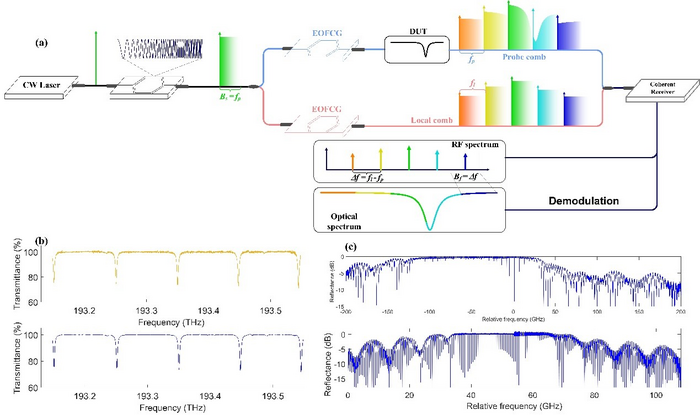A new publication from Opto-Electronic Advances; DOI 10.29026/oea.2022.210023 considers sub-femtometer-resolution absolute spectroscopy based on dual electro-optic frequency comb.

Credit: OEA
A new publication from Opto-Electronic Advances; DOI 10.29026/oea.2022.210023 considers sub-femtometer-resolution absolute spectroscopy based on dual electro-optic frequency comb.
Optical frequency comb (OFC) provides equidistant comb lines in broad bandwidth, and each comb line corresponds to an absolute optical frequency, which is similar as a comb (or rule) in optical frequency. As the development of femtosecond mode-locked laser and nonlinear optics, in 1999, research groups from National Institute of Standard and Technology (NIST) and Max-Planck Institute for Quantum Optics (MPQ) respectively realized OFC in experiments, which solved the problem of absolute optical frequency measurement, therefore J. H. Hall and T. W. Hänsch were awarded the 2005 Nobel prize in physics. OFC also revolutionized the field of spectroscopy that the spectral resolution reached picometer level (repetition rate of OFC), and new techniques and applications of comb-based spectroscopy have also emerged.
Dual-comb spectroscopy (DCS) may fully utilize the excellent characteristics of OFCs in terms of frequency accuracy, frequency resolution, spectral range and pulse width, which stands out among comb-based measurement techniques. In the frequency domain, DCS is multi-heterodyne detection of two OFCs with small difference in repetition rate, and may transfer the recorded spectrum, such as molecular absorption spectrum, from optical frequency to radio frequency. Spectral resolution of DCS may be improved to tens of femtometers by using spectral interleaving technique. However, there are still many disadvantages of these existing techniques. For example, the measurement time is very long, and the temperature-based or driving current-based tuning techniques cannot provide absolute frequency reference. Moreover, there is still room for spectral resolution to be further improved to the level of comb line linewidth.
Electro-optic frequency combs (EOFCs) generated by electro-optic modulation from a continuous-wave seed laser, have intrinsic mutual coherence in DCS without complicated phase-locking circuits or phase corrections, which significantly reduces the system complexity. Besides, EOFCs provide repetition rate without limitation of cavity length, and provide adjustable center wavelength, therefore, DCS based on EOFCs has application prospect and attracts the attention of researchers.
The research group of Prof. Xinyu Fan from Shanghai Jiao Tong University propose a novel DCS technique based on EOFCs, which further improves the spectral resolution of two orders of magnitude to sub-femtometer. The stabilized seed laser is external modulated to serve as the seed lightwave of sweeping EOFC, which enables fast spectral interleaving with low frequency error, and provides absolute frequency reference. Based on the analysis of theoretical limitations and trade-offs of the key parameter, the research group improves spectral resolution, bandwidth, and measurement time to Nyquist-limitation. The measurement results of molecular absorption spectrum and high-Q fiber Fabry-Perot resonance spectrum demonstrate the ultra-high spectral resolution, high measurement signal-to-noise ratio, and fast measurement of the proposed technique. This research achievement may further promote the development of hyperfine comb-based spectroscopy, and may be implemented in green gas monitoring, precise optical device test, biochemical sensing, and physical phenomenon observation, such as electro-magnetically induced transparency.
Article reference: Xu BX, Fan XY, Wang S, He ZY. Sub-femtometer-resolution absolute spectroscopy with sweeping electro-optic combs. Opto-Electron Adv 5, 210023 (2022). doi: 10.29026/oea.2022.210023
Keywords: dual-comb spectroscopy / optical frequency comb / interferometry
# # # # # #
Professor Xinyu Fan, School of Electronic Information and Electrical Engineering (SEIEE), Shanghai Jiao Tong University, is mainly engaged in the research of optical sensing and optical measurement technology. Professor Fan has undertaken more than 20 scientific and technological projects such as the National Natural Science Foundation of China (NSFC) and National Key R & D Sub-project. At present, he is a council member of China Optical Engineering Society (COES), executive council member of optical fiber sensing technology committee, guest editor of Optics Express, editorial board member of Chinese Optics Letters, and topic editor of Sensors. He has cultivated many students who won best paper awards at many international conferences. He was granted the excellent instructor award by China Education Society of Electronics (CESE). In recent years, he is focusing on how to break through the practical bottleneck of optical sensing and optical measurement technology, and made progresses in the industrialization promotion of these technologies. Based on these achievements, he was awarded the First Prize for Technological Invention Achievement of the Ministry of Education (MOE) of China.
# # # # # #
Opto-Electronic Advances (OEA) is a high-impact, open access, peer reviewed monthly SCI journal with an impact factor of 8.933 (Journal Citation Reports for IF2021). Since its launch in March 2018, OEA has been indexed in SCI, EI, DOAJ, Scopus, CA and ICI databases over the time and expanded its Editorial Board to 36 members from 17 countries and regions (average h-index 49).
The journal is published by The Institute of Optics and Electronics, Chinese Academy of Sciences, aiming at providing a platform for researchers, academicians, professionals, practitioners, and students to impart and share knowledge in the form of high quality empirical and theoretical research papers covering the topics of optics, photonics and optoelectronics.
# # # # # #
More information: http://www.oejournal.org/oea
Editorial Board: http://www.oejournal.org/oea/editorialboard/list
All issues available in the online archive (http://www.oejournal.org/oea/archive).
Submissions to OEA may be made using ScholarOne (https://mc03.manuscriptcentral.com/oea).
ISSN: 2096-4579
CN: 51-1781/TN
Contact Us: [email protected]
Twitter: @OptoElectronAdv (https://twitter.com/OptoElectronAdv?lang=en)
WeChat: OE_Journal
# # # # # #
DOI
10.29026/oea.2022.210023




